We have supplies for your upcoming hunt. Stock up HERE and have the things you want shipped right to your doorstep.
Mule Deer Fanatic
Bringing the Mule Deer world together, one hunter at a time
Archive for 2009
New Typical Record Book Buck
What do you think? Is this a new world record typical mule deer buck?
—————————————————-
 Email submitted by Paul Baxter
Email submitted by Paul BaxterThis deer was shot 12 miles east of Monticello, Utah by Max Johnson in
1968. He kept it at his home and didn’t think much about it until his
son took it to the 2009 International Sportsman’s Expo in Utah. The
Safari Club staff had a booth near by and asked if they could measure
it. According to it’s method of scoring, it was 228. The Safari Club
folks returned it and announced that it was now the Club’s new world
record.
Max’s son is Keele Johnson, a good friend of mine and a former Utah
legislator, is one of the guides on the moose hunt with me in Alaska.
RG
Young Hunter kills first Archery Buck on North Rim

A 22 year-old hunter from Globe Arizona arrowed this nice buck mule deer on the second day of the Unit 12 bowhunt. He was standing near a meadow in a rain storm watching two bucks feed past him. He shot the smaller of the two – claiming that the larger buck was huge. The larger buck never presented an acceptable shot so he shot the smaller one instead. This is his first archery buck and he may have a hard time doing better.
North Rim Bowhunt
I bowhunted the North Rim this year and attempted to talk to as many hunters as possible. Most hunters were seeing bucks and most were getting some shots, but only five, that I’m aware of, bagged bucks. There was rumor of a big buck being taken from the southwest quadrant on opening day, then there was this buck taken by a young man who said he missed shots at some big ones:

This young man was with an older person who had spent considerable time scouting and preparing for the upcoming rifle hunt. Here are a couple of his friend’s tree cam shots:


Getting an archery buck from the North Rim is difficult, but there are a few good ones available.
Send in your Stories and Photos
We would be happy to hear from you about your mule deer hunts for 2009
—————————————————-
To submit a story and/or photos click on the “CONTACT ” tab at the top of the page. We will reply to your email and you can then send us your story with photo attachments.
If you have any problems, let us know
Happy Hunting and may the Force be with you, and
Remember to shoot STRAIGHT

Admin
A Good Antler Growing Year
Earlier in the year, some folks were predicting that it would be a good year for antler growth, based on a wet spring and good feed. Having now been out bowhunting, I have the following observations for Southern Utah and Northern Arizona:
- Most of the yearling bucks have antlers much larger than normal.
- There are not as many yearling bucks as in the previous few years.
- Mature bucks have heavy antlers except for finishing off the back tines.
- The majority of bucks are in the 3-5 year-old class
- There are a larger than usual number of 20-27″ typical four-point bucks
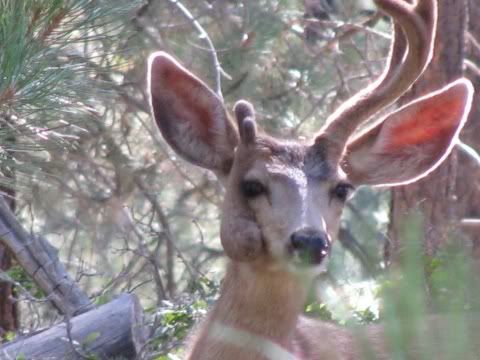
Wolves on the Attack in Wyoming
The following story was emailed to me. I consider the source reliable and the pictures substantiate the story. What does this have to do with Mule Deer? I’ll let you figure that out. The author was apparently in Wyoming where wolves are having a hey day on game animals.
———————————–

I had one heck of an experience this past Friday. I was walking into an area I spotted 5 bulls last weekend when wolves started howling, growling and snarling about 300 yds away in the timber below me. It was just getting light so, I hung out for a while hoping to get a look at the wolves. Nothing appeared so, thinking that there were probably no elk in this spot, I headed back to the truck. I unloaded the ATV and was headed to an area called the “Natural Corral” on Bald Ridge.
About ½ mile down the dirt road I came upon a herd of cattle running around in a circle and making all sorts of sounds. The herd parted and 2 wolves popped out to look at me. Just beyond the two was another wolf on the hind end of a cow pulling a chunk of flesh from the cow that was still alive. The two wolves ran to my right and stopped about 50 yds away.
The wolf on the cow jumped off and stood on the road. I charged him with the ATV and he ran to my right and stopped 25 yds. away. I had my .44 mag and could have popped him, but knowing the penalty for killing a wolf, I pulled out the camera instead and took a picture of him while he was running away. It’s a grueling sight to see an animal being eaten alive.
I called 911 to get the local Game Warden, Chris Queen. He called back and was heading to the spot after he finished loading hay. I asked if I should put the cow down since it was still alive. He knew the owner of the herd and said not to finish it since the owner was particular about killing his cattle.
Chris called Mark Brucino, USF&W biologist that handles wolves and grizzlies in the area. Mark called me back to say he was on the way. I told him that I was heading back out to look for elk and would be back later.

The wolves starting to attack the herd again further down the road behind me. I took off down the road, but the wolves were gone. I got back to elk hunting and spotted 3 groups of cows, calves and spike bulls totaling 41. A plane appeared and was flying transect patterns. I knew it must be FWS people. The elk didn’t care for the plane and slowly head back into cover. This was not working for elk hunting so I twisted off the hunt and headed back to the truck. At the kill site I met Mark and an agent with USDA Wildlife Services (formerly Animal Damages Board), Monty Nicholson. Mark said they were trying to pick up any signals from collared wolves. None of the wolves I saw had collars. After explaining my account of the situation and a description of the wolves they made a decision to call in a chopper and hunt them down. The chopper came in and Monty jumped in with a 12 gauge and #4 Buckshot, his standard load for killing wolves and coyotes from a chopper.
Monty had explained that the area I was in is the border for 3 wolf packs; Sunlight Basin, Absaroka and Clark’s Fork. He believes these 3 wolves are lead by a older male wolf that walks with a limp. Because of the injury the older wolf cannot compete with stronger wolves for females and is leading the 3 younger males. The older wolf has a radio collar, however the plane did not pick up the signal.
Soon the rancher and trail riders arrived. Mark wrote out a ticket for the rancher to get reimbursed “7 to 1″ meaning he will get paid 7 times the cost of the 2 yr. old cow. It is based on the assumption that the cow would be able to produce 7 calves during the life span. Of course the money comes from the State even though the Feds brought the wolves into WY and now we have to deal with the mess.
What was the cost of this one situation?
– Time for 1 DOI FWS biologist
– Time for 1 USDA Wildlife Services agent
– Time for 1 WY Game Warden
– Flight time for 1 surveillance plane
– Flight time for 1 chopper
– Payment for 1 cow (.85/lb x 1000 lbs x 7 = $5,950)
So much for wolf management in WY. I could have helped out for the low, low price of one .44 mag round. At least I could have taken care of ¼ of the pack!
———————————-
Story submitted by Paul Baxter
Lions cannot kill Bighorn Sheep just Mule Deer
The following quote demonstrates to me that the USFWS is more anti-sportsman than pro and is an agency with far too much power over state wildlife agencies. State wildlife agencies have their issues as well, but provided that a state agency wishes to serve the sportsmen that fund them, they must still cope with the USFWS.
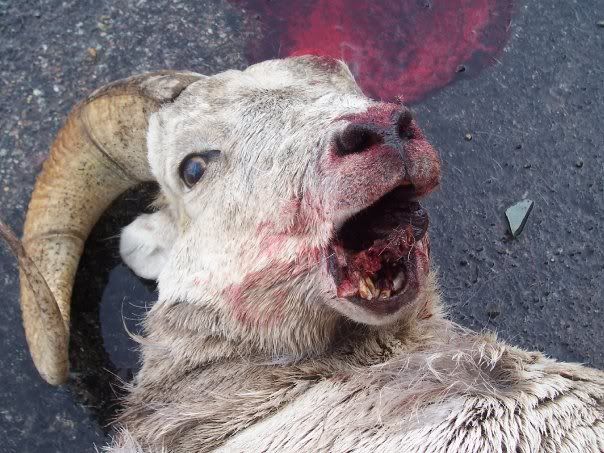
We need to stop lions from killing mule deer as much as we need to stop them from killing big horn sheep. At present lions are killing over ten times as many mule deer as hunters are annually.
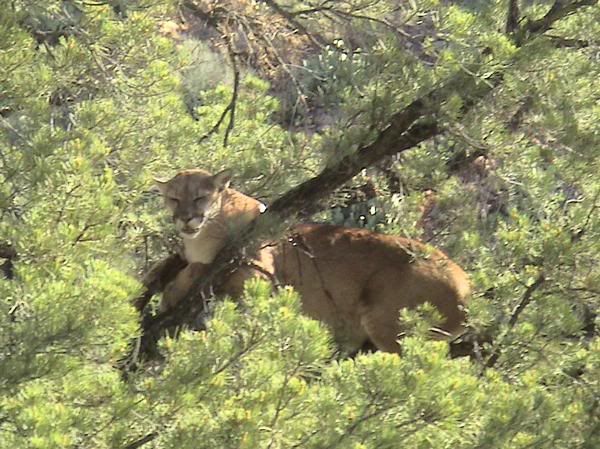
———————————
On Friday, TOMORROW, August 7 the Arizona Game & Fish Commission will consider extending the Kofa lion removal moratorium which ended July 31. It is critical to the survival of the Kofa herd that the moratorium NOT BE EXTENDED.
According to information provided by the Az. Game & Fish Department (AZGFD) the Kofa desert bighorn sheep population declined from 800 sheep in 2000 to 390 sheep in 2006. Predation by mountain lions was found to be one of the causal factors in the decline.
Based upon that report the AZGFD developed a variety of action plans to address the identified issues, including a mountain lion predation management plan. As part of the predation management plan, two mountain lions that were trapped on the refuge were lethally removed and the USFWS was immediately challenged for allowing these activities to occur prior to completion of an Environmental Analysis (EA).
At the request of USFWS, the Department agreed to a one year Moratorium on lethal removal of lions captured on the refuge.
On April 23, 2008, the USFWS released a scoping letter to gather input prior to completing the EA.
In 2008, at the request of Arizona Sportsmen for Wildlife, the Arizona Legislature sent a House Concurrent Memorial to Congress on this very issue. The Legislature asked Congress to “take immediate action to reaffirm the Arizona Game & Fish Department’s position as the leading agency in the management of non-migratory and non-endangered state wildlife” and that the AZGFD be allowed to “employ, without any unnecessary delays, burdens or obstacles, all management tools and measures necessary to recover the Kofa National Wildlife Refuge desert bighorn sheep population, including the management of predators, water developments, human intervention and the potential for disease epizootics. To date, no action has been taken by Congress and USFWS has done nothing to facilitate or otherwise allow AZGFD to manage its wildlife in the Kofa.
On April 18, 2009 the USFWS requested an additional extension of the Moratorium indicating they needed more time to complete the EA. The Commission extended the Moratorium for 90 days and that moratorium ended on July 31, 2009.
Today, while the USFWS has printed its findings from the EA in the Federal Register, it is highly unlikely that a final decision will be made before March 2010 and mountain lions will continue to kill sheep on the Kofa. At last report one of the offending lions known as KMO4 has killed 14 sheep, averaging one sheep every ten days. And KMO4 is not the only offending lion on the Kofa. The Department’s Timeline shows that sheep have been taken by more than one other offending lion on the Kofa.
According to an article in the Arizona Republic, Representative Daniel Patterson (D-Dist 29, Tucson) does not want the AZGFD to shoot lions until the federal government finishes an environmental study on the issue early next year as requested by USFWS. AZSFW does not agree with Representative Patterson as the facts of offending lion, KMO4, speak for themselves.
Rep. Patterson was formerly affiliated with the Southwest Center for Biological Diversity and is reported to be the Ecologist and Southwest Director for Public Employees for Environmental Responsibility since 2006.
It is time for the Commission to say “No More Time” and direct the Department to lethally remove the offending lion as soon as possible. It is the responsible thing to do.
Please call or write members of the Commission and ask them to support AZSFW’s request to lethally remove the offending lion and tell USFWS no more moratoriums. The Kofa desert bighorn sheep herd can no longer afford to be held hostage to bureaucratic inefficiencies.
Pete Cimellaro
AZSFW Board Member
Loose Lion
When you see a lion, you know there are too many. This story comes from Washington and is a sample of a situation that is growing more and more common. Why is it so, you ask? Some say we are encroaching on lion territory. We have always done that. I say it is because there are too many lions.
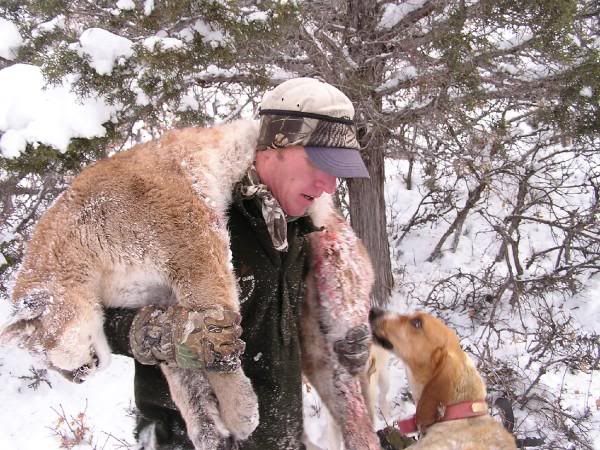
One less lion, many more deer
——————————————
Sightings of a cougar in Beaver Brook and the west side of Barrhead are more a cause for caution than alarm, wildlife officials say.
Derek Brendzan, a Barrhead District Fish and Wildlife officer, said drainages on the west side of town that lead into the Paddle River are used as highways for predators to follow their prey. In recent years, a large number of mule deer have been migrating along a north-south corridor that stretches along the west side of town through Beaver Brook.
A cougar may have moved in to feed on these deer, he said.
To date, Barrhead District Fish and Wildlife has received about four cougar sightings. Some of the descriptions can fit either a cougar or a coyote, Brendzan said. Wildlife officers have not been able to confirm the presence of a cougar or a cougar’s kill, but Brendzan would not be surprised if one of the animals was in the area.
Town staff recently installed signs along the west side of town alerting people to the sightings and providing safety tips.
Brendzan emphasized that people should not be overly concerned but should exercise caution in the area, especially in the early morning and at dusk, as the animals are nocturnal.
Fish and Wildlife will continue to monitor any sightings.
“As long as it’s doing its thing, we leave it alone,” Brendzan said. “If it comes to the point that it starts impacting people or property, then we come along and remove it.”
Beaver Brook resident Theresa Cherwonka was walking to the health club at about 7:00 a.m. two weeks ago. While she was on a path behind the Champion Feed Services building, a truck backfired and a large animal dashed across the path.
“At first I thought it was a coyote, but no – it didn’t have the head of a coyote. It had the head of a cat,” she said.
Cherwonka described the animal as being about “15 inches deep and six to seven feet long (outstretched) as it leaped, with an orangy-brown colour.”
The sighting unnerved her and she took a different route home, where she called Fish and Wildlife to make a report.
Cougar sightings are very rare. They can sometimes cause alarm in a community because they are “large carnivores that we are not used to,” Brendzan said. Brendzan has spotted only two cougars in the wild in his 10 years with Fish and Wildlife.
Attacks on people are far rarer. Citing a 2006 study by the American Academy of Forensic Sciences, Brendzan said North America has seen fewer than 12 human deaths by cougar attacks in the 100 years prior to the study. By comparison, the study said about one death a year occurs in the United States from domestic dog attacks.
If a cougar is in fact in the area, Brendzan said the mule deer will most likely leave once several have been taken. The cougar will then probably follow its prey out of the town as well, he added.
Pamphlets with safety tips and information on cougars are available at the Fish and Wildlife Office, the Town Office and the County Office. Any sightings of cougars or possible cougar kills can be reported to the Barrhead Fish and Wildlife Office at 780-674-8236.
Utah has a Love Affair with Bears
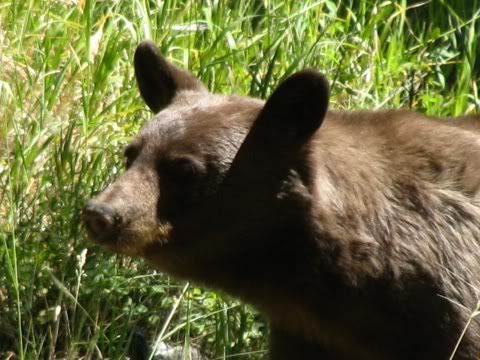
Bear attack in Utah
Last week I took a vacation to film mule deer in Southern Utah. The first night in camp, my friend and I had a bear visit us. Long story short, my friend insisted on leaving, but before and after that, some interesting events transpired.
About 3:00am on Thursday, August 6, my 72 year-old friend awoke and was having a difficult time breathing because of the change in altitude. He asked me to get him a chair to sit in. As I stumbled out of the tent, he followed up with a comment about hearing an animal outside the tent. I responded, “it’s probably a cow”. No sooner was I out the tent door and in the moonlight, than I could see a bear in our camp. I told Byron we had a bear. Sometime in the next few minutes, while I was involved with the bear, Byron escaped the tent to get in the truck.
I spoke to the bear and asked him to leave, but to no avail. While I was trying to keep track of the bear and assess his activities in our camp he would back off and then move in again. I got my spotlight and shined it on the bear which seemed to have no effect whatsoever on his desire to be in camp with us. I grabbed the video camera and filmed with one hand while holding the spotlight with the other. At the end of the taping session he was within 20 feet, and I again asked him (it) to leave. No success.
I started the fourwheeler, turned on the headlights and went after the bear. Reluctantly, it yielded to the four wheeler. I got in the truck with Byron and we decided to sleep there ’til daybreak. Byron was soon sleeping and breathing easily. At daybreak, I snuck out of the truck to go do some early morning filming. I left Byron asleep. When I returned, Byron was a little excited. He said he had been awakened by the truck rocking back and forth only to see the bear’s nose on the window of the truck. He kicked at the window (I’m glad he didn’t break it), yelled, and honked the horn. It didn’t have much effect, so he rolled down the window and yelled at the bear. Finally, it left, and then I returned.
Byron was ready to leave and I obliged him by taking him half way home where he met a friend. I returned to the mountain. The bear had eaten a loaf of bread and two bottles of soda, all of which were sealed. I surmised that this bear was experienced. I made sure all food was secured inside the truck and left everything else as it had been. That night the bear returned. I threw rocks and sticks at it and drove it off.
At daybreak, I again left to film mule deer. Upon my return, to my grief, the bear had done considerable
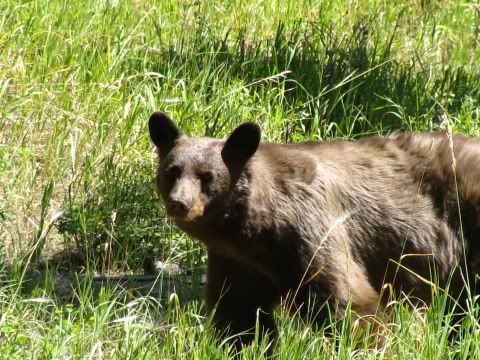
Black Bear Circling Camp
damage to all my containers and their contents. I stayed up ’til 1:00 in the morning cleaning up the mess. Among the damaged items was my cookstove. The propane had somehow been turned on in the frucas and all the fuel was gone. Anything that could be destroyed had been destroyed except the tent and the lantern. That included a gas can which was carried out into the trees and chewed up.
On the next visit, the bear broke the lantern which was hanging quite high in a tree and tore down the tent, chewing holes in it and ripping the foam mattresses up. I was mad as heck. I wished I had a weapon. I got together some fist-sized rocks and some good solid clubs and decided to fight back. The following day the bear returned in broad daylight, and I was in camp. I threw rocks and sticks at it but it wouldn’t leave. It started circling camp, so I decided to video and take photos of it. I kept myself between the bear and camp. It made several mock charges at me. I believe that it would have made good had I shown any fear. After filming for a while, I decided to run over the bear with my four wheeler. I went bouncing out through the trees over rocks, logs, and brush and the bear stayed ahead of me. It then began paralleling the road so I followed. I hoped catch it in an open area along the road where I could run over it.
We went along slowly and then the bear came up to some cows which behaved as though they were going to collectively challenge the bear. Mr. Bruin made a rush toward the cattle and they ran away. Then two deer came bursting accross the road. It looked like my antagonist was going to go after the deer. I started to close the gap. Once he was where I had a clear shot at him, the bear kicked it into high gear. So did I. I smoked the clutch pushing the four wheeler as hard as it could go, but I couldn’t catch the bear.
After that, I had cows in camp instead of the bear and the cows were welcome guests. I waited every subsequent night for the bear to enter the tent. I was ready with a spotlight and clubs. He never came. I did get some good footage of mule deer bucks and assorted other wildlife which will be shown in an upcoming DVD series.
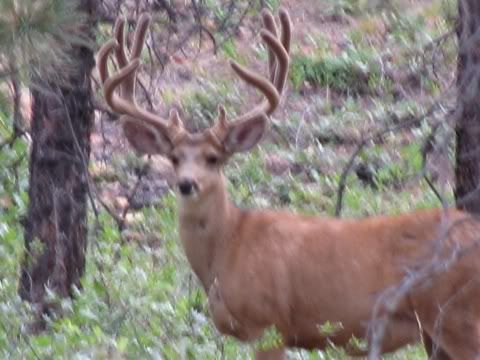
Buck I filmed
When I left, I stopped at Quinn Howe’s Shamrock to get some gas. I told him about the bear and he said the DWR had just hauled a bear up on the mountain that was causing trouble in another area. He thought I might have been the victim of their foresight
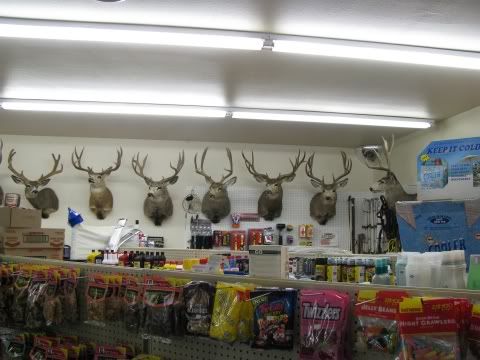
Big buck mounts in Quinn's Store







